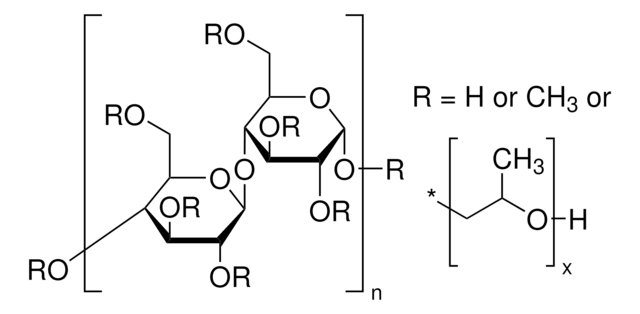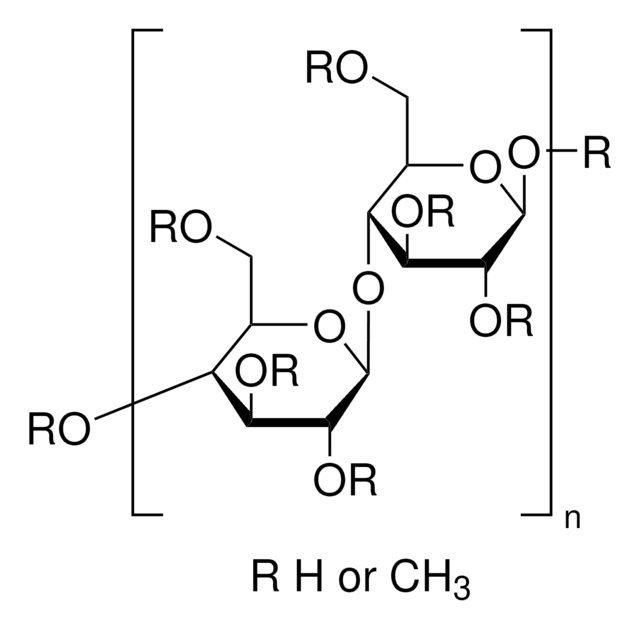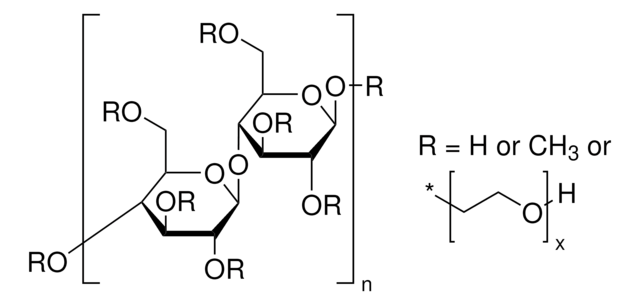H9262
(Hydroxypropyl)methyl cellulose
viscosity 80-120 cP, 2 % in H2O(20 °C)(lit.)
Sinonimo/i:
2-Hydroxypropyl methyl cellulose ether
Autenticatiper visualizzare i prezzi riservati alla tua organizzazione & contrattuali
About This Item
Prodotti consigliati
Forma fisica
powder
Livello qualitativo
PM
~26 kDa
Colore
beige
Viscosità
80-120 cP, 2 % in H2O(20 °C)(lit.)
Cerchi prodotti simili? Visita Guida al confronto tra prodotti
Applicazioni
(Hydroxypropyl)methyl cellulose acts as a thickener for aqueous and non-aqueous systems, is a water retention aid and steric stabilizer, and clear films with grease resistance. (Hydroxypropyl)methyl cellulose has been used to study mucoadhesion in the design of drug delivery systems to prolong intestinal residence time and has also been used to study the enhancement of dissolution rate of poorly water soluble drugs.
Thickener for aqueous and non-aqueous systems, clear films with grease resistance, binders, lubricants, steric stabilizer and water retention aid.
Caratteristiche e vantaggi
Dissolves in water, undergoes reversible gelation upon heating, non-ionic, does not complex with ionic species and is surface active and enzyme resistant. Solutions are pseudoplastic.
Altre note
To gain a comprehensive understanding of our extensive range of Polysaccharides for your research, we encourage you to visit our Carbohydrates Category page.
Codice della classe di stoccaggio
11 - Combustible Solids
Classe di pericolosità dell'acqua (WGK)
WGK 1
Punto d’infiammabilità (°F)
Not applicable
Punto d’infiammabilità (°C)
Not applicable
Dispositivi di protezione individuale
Eyeshields, Gloves, type N95 (US)
Certificati d'analisi (COA)
Cerca il Certificati d'analisi (COA) digitando il numero di lotto/batch corrispondente. I numeri di lotto o di batch sono stampati sull'etichetta dei prodotti dopo la parola ‘Lotto’ o ‘Batch’.
Possiedi già questo prodotto?
I documenti relativi ai prodotti acquistati recentemente sono disponibili nell’Archivio dei documenti.
I clienti hanno visto anche
Deirdre M D'Arcy et al.
AAPS PharmSciTech, 20(2), 47-47 (2019-01-09)
Viscosity, influenced by medium composition, will affect the hydrodynamics of a dissolution system. Dissolution simulation methods are valuable tools to explore mechanistic dissolution effects, with an understanding of limitations of any simulation method essential to its appropriate use. The aims
Lucas Sievens-Figueroa et al.
International journal of pharmaceutics, 423(2), 496-508 (2011-12-20)
The design and feasibility of a simple process of incorporating stable nanoparticles into edible polymer films is demonstrated with the goal of enhancing the dissolution rate of poorly water soluble drugs. Nanosuspensions produced from wet stirred media milling (WSMM) were
A Akbarian et al.
Poultry science, 93(8), 1930-1941 (2014-06-17)
Heat stress in poultry is a serious problem in many countries and has been associated with oxidative stress. Hence, nutritional interventions with antioxidants might be beneficial. Therefore, the effects of dietary Curcuma xanthorrhiza (CX) and Origanum compactum (OC) essential oils
Francis W Hunter et al.
Biochemical pharmacology, 89(2), 224-235 (2014-03-19)
The nitro-chloromethylbenzindoline prodrug SN29428 has been rationally designed to target tumour hypoxia. SN29428 is metabolised to a DNA minor groove alkylator via oxygen-sensitive reductive activation initiated by unknown one-electron reductases. The present study sought to identify reductases capable of activating
Michelle Lay Teng Ang et al.
Infection and immunity, 82(5), 1850-1859 (2014-02-26)
Tuberculosis remains a major worldwide epidemic because of its sole etiological agent, Mycobacterium tuberculosis. Ethionamide (ETH) is one of the major antitubercular drugs used to treat infections with multidrug-resistant M. tuberculosis strains. ETH is a prodrug that requires activation within
Il team dei nostri ricercatori vanta grande esperienza in tutte le aree della ricerca quali Life Science, scienza dei materiali, sintesi chimica, cromatografia, discipline analitiche, ecc..
Contatta l'Assistenza Tecnica.




